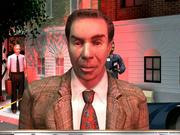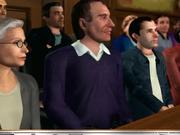The level of success that Dick Wolf's Law & Order franchise has enjoyed is actually pretty staggering. The original series launched in 1990 and since then has become one of the most beloved crime dramas on television, spawning two successful spin-off series and helping to make household names out of actors like Jerry Orbach, Sam Waterston, Benjamin Bratt, Angie Harmon, Jill Hennessy, and Michael Moriarty. Last year, the franchise branched out into the realm of PC gaming with Vivendi Universal and Legacy Interactive's Law & Order: Dead on the Money, an interactive mystery that let you take the reins of both the detective in charge of a murder and the prosecutor charged with putting the perp behind bars. At its core, Dead on the Money was a simple adventure game with some irritating structuring problems and decent, though uninspired, presentational aspects. The follow-up to Dead on the Money is Law & Order II: Double or Nothing, and, for better or for worse, the sequel has a style and methodology that are similar to the original. However, a far more engaging storyline and a less-intensive reliance on the player's knowledge of legal procedures definitely makes Double or Nothing a better game.

Like its predecessor, Law & Order II is structured exactly like the show. The game opens with the seemingly random shooting of a famed scientist on a busy New York street. Initially, your task will be to partner with longtime Law & Order mainstay Detective Lennie Briscoe (Jerry Orbach's character) so you can put the pieces together as to what happened. You'll need to collect evidence at the crime scene and send it off to the crime lab for analysis. You'll then have to interview witnesses, as well as perform background research into these witnesses. Periodically you'll have to place surveillance officers on their tails. Once you've done some digging, you'll then have to collect your evidence and put together search and arrest warrants.
With a suspect in custody, the game's focus then shifts to the prosecution. You'll take the evidence collected in the first half and try to make a case against your suspect by subpoenaing witnesses and deciding what evidence you'll need in court. Once you're in court, you'll have to question experts and witnesses, trying to prove beyond a shadow of a doubt that your case is as solid as possible. The defense will try to cross-examine your witnesses, and, in so doing, they will attempt to undermine your case. Here's where things may get tricky, as you'll have to know when to object to questions asked by the defense. Objectionable questions are wide and varied, but they are usually made obvious by notable shifts in tone from the defense attorney. Likewise, the defense will object if you ask the wrong types of questions. You'll also still have some investigative work ahead of you, as not every aspect of your case will come together properly. This means that you'll periodically have to find new evidence, as well as new witnesses.
Each of the tasks ahead of you can be made simpler by selecting from a list of skills at the beginning of the game. Skills include teamwork, which provides you with hints from your superiors about what direction you should take your case next; interview skills, which eliminate unneeded questions from your available selection, making interviews more expedient and to the point; case organization, which gives you tips on which pieces of evidence and testimony are key to getting a needed warrant or subpoena; and evidence collection, which prompts a magnifying glass icon over your cursor to signify items that might be worth collecting. You'll only have two to choose from, and, unfortunately, you may find yourself partially into the game when suddenly you realize that you didn't choose one of the skills you need most to help you. Sadly, the only way to switch skills is to start the game over from the beginning.
Despite this one limitation, however, Double or Nothing is a much less restrictive game than its predecessor. For one, the game has no time limitations to speak of, whereas before you had only a four-day window in which to complete your investigation of the crime. Additionally, the game's legal interface has been simplified so that you don't have to know much in the way of legal mumbo jumbo to get through a trial. Occasionally, situations will pop up where, during the trial, a piece of evidence may be challenged by the defense because of one rule of admission or another. You'll then have to explain to the judge why the piece of evidence is admissible, based on some sort of legal loophole. Thankfully, as with the game's interview process, you'll have three options to choose from, and the correct option is usually the most logical sounding one. If you do get it wrong, you can always go back from your last save and try again.
What is really best about Double or Nothing is its plot. The storyline is rife with twists and turns, and it even features an underlying theme one could even coin as "ripped from the headlines." Much like in the TV show, not everything in the game is as it seems, and you'll constantly have to keep tabs on all of your witnesses to keep track of who is really telling the truth and who is hiding something. Additionally, when prosecuting your case, you won't just have a cut-and-dried case, as key pieces of your evidence may be thrown out of court because it was collected without a search warrant. The defense may even introduce elements you weren't aware of to attack your proposed motive. At times, the story does seem to get a bit bogged down by its own convolutions, but, ultimately, it's an excellent interpretation of the show's style of storytelling.

In terms of presentation, Law & Order II is practically identical to last year's game in every way. The game uses the same menu system and overall visual layout as before, and the same type of 3D models are used for each character. This is not a bad thing, by any means, as the game does look pretty decent, but a bit more of a visual upgrade would have certainly been welcomed. Jerry Orbach, Elizabeth Röhm, and S. Epatha Merkerson all reprise their roles, and, for the most part, they do a convincing job (although Röhm is more than a bit wooden in her line delivery). The supporting voice talent is of equal capacity, if not superior in some cases, and the game's soundtrack is nicely varied depending on where you are.
Law & Order II is ultimately the same basic game as the first Law & Order title, but the bulk of the gameplay issues found in the first release have been addressed here in the second one. Double or Nothing is legitimately challenging and intriguing, which makes for a more enjoyable experience all around. Make no mistake, the game certainly won't appeal to everyone. Diehard adventure game fans may find Law & Order a bit too single-minded for their tastes, but any fan of Law & Order will find plenty of elements to appreciate about Double or Nothing. If you have even a passing interest in the show, you should at least give Law & Order II: Double or Nothing a look.